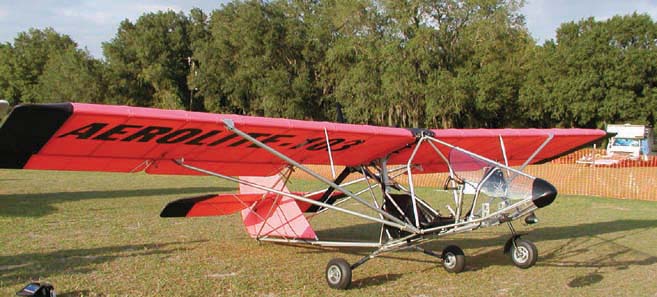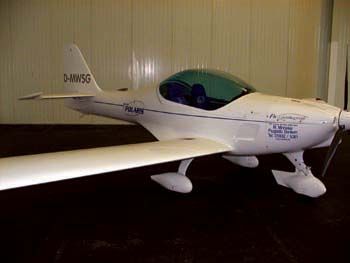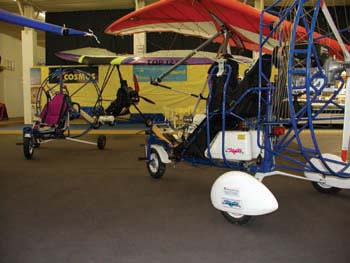
Simple American designs such as the Aero-103 will always be popular thanks to low price and good performance with small engines.

Aluminum construction is still popular in Europe due to the influence of engineers working at former Soviet design bureaus like Antonov. This is the G 97 Spotter from Italy.

Ready to fly, the TL 232 Condor (foreground) and the TL 96 sell for about $35,000 and $60,000 respectively. Both list a 990-pound gross weight, fitting the European ultralight regulations.

University and government research results in projects like the
experimental wingtip on this Dyn’Aero airplane. This tip is said
to make the effective wingspan about 3 meters longer.

Fisher Flying Products is one of several U.S. companies that produce wood airplane kits such as this FP-101.

Stainless steel is not commonly used on trikes, but this European model is an exception.


Events of last fall changed many things, among them the FAA’s action to push through the proposed sport pilot rule with its definition of a new class of aircraft.
Work on the proposed rule has slowed as the FAA focuses on efforts to ensure the air transport system is intact for millions of airline travelers. New rules for aircraft flown primarily for fun were necessarily put on the back burner.
As we’ve noted in these pages before, the proposed rule offers significant promise to light aviation, and many experts are sure that the sport pilot NPRM (notice of proposed rulemaking) will still be released for public comment, followed at some point by a new rule. Certainly it represents a breath of fresh air, and that may be just what a beleaguered FAA needs come springtime.
Possibilities
I’ve had the pleasure of flying a great many of the light aircraft introduced over the last 25 years. More recently, I’ve been logging time in the newest light aircraft. Specifically, I’ve been targeting those machines that could represent the first wave of light sport aircraft, the name the FAA has chosen for the aircraft side of its proposal; the term sport pilot is the pilot credential side.
While American companies will respond with designs of their own aimed at the opportunity represented by the new rule, all manufacturers must cope with the FAA rules regarding production of these aircraft. As builders await guidelines to obtain a production certificate, designers believe that many models will need only adjustments such as different engines and props to optimize the operational parameters of the proposed new rule.
Other brands—such as RANS, Quicksilver and Zenair—have already demonstrated processes for certified production, putting them ahead in the race. Some manufacturers say they choose not to pursue certification and will continue to produce kits. While the home team organizes itself, many Europeans believe they are ready.
Two of the most significant parts of the proposed definition are the gross weight of 1232 pounds and the maximum speed of 115 knots (132 mph). A large number of designs are well along in the process of meeting these parameters. At shows in Europe, dozens of such aircraft are displayed. Though many boast speeds beyond the FAA’s 115-knot expected limit, several companies say that the right engine and prop combination can make a speedier machine fit the proposed standards. In my conversations with numerous European aviation leaders, I hear great anticipation of the sport pilot rule.
Many European ultralights employ composite construction. In Europe, a 450-kilogram (992-pound) weight is permitted, and this has allowed the use of space-age materials that Americans see on heavier kits such as the Lancair, Glasair and Pulsar.
Thanks to the influence of an entire generation of young engineers trained in facilities like the Antonov Design Bureau, aluminum monocoque construction has also increased in popularity. Once the Iron Curtain fell, many companies were formed by displaced engineers, and their machines are beginning to populate European airfields.
Old Birds
As I review the airplanes that may qualify for sport pilot, two categories emerge. First is a series of “old” designs. These actually resemble American aircraft to a great extent in that they are made of aluminum tubing, with some steel used in landing gear and engine mounts. Coverings are often sewn Dacron or sometimes dope and fabric. While a few of these designs are still being manufactured in Europe, this configuration represents the majority of U.S. designs.
Just like the composite-versus-aluminum-skin debate, many can successfully argue that despite the sleek shapes possible with composite materials, the older methods are proven, economical to build, and have established supply channels that are important to smooth, steady production.
Aircraft in this category include the S-6 and Airaile series from RANS, the Flightstars, Quicksilver’s MX and GT, the Hawk series from CGS, Golden Circle’s line, and the Challenger ultralights.
Some “old-style” designs from Europe continue to sell well. They include the C-42, which Americans know as the Cyclone, once marketed by Flightstar. And the biggest, best-known group includes trike ultralights from several established manufacturers like Air Creation, Cosmos, Pegasus and AirBorne.
New Birds
In the last decade, several new designs have been offered by European builders, and they constitute a second category. Many are gorgeous constructions that would catch the eye of any American aviator. Models of this description include the Flight Designs CT, the Dallach Fascination D4, B&F Technik’s FK-14 Polaris, and the Zephyr.
Nearly all European designs built from composites share one common thread: They are built in Eastern European countries such as the Czech Republic, Ukraine and Poland. Production in this area offers great labor savings with experienced engineers willing to work for less than $400 a month. These emerging businesses tap a ready supply of trained labor eager to work in private companies after the collapse of the Soviet Union more than a decade ago.
Are we moving away from the older aluminum tube and Dacron designs to composite airplanes? No one knows yet, just as we don’t know whether composite homebuilts or factory aircraft will make obsolete the aluminum of Cessna and Piper.
Painless Purchase Potential
Given the anticipated arrival of sport pilot sometime this year, the big question is: What should you buy? And when?
Last year’s announcements of the FAA’s proposed new rule caused many potential buyers to wait. In addition to the events of September 11, this has resulted in slow sales that may jeopardize some manufacturers.
With the rule stalled, that sluggishness may not correct quickly. However, pilots are encouraged to recall that while the new rule will bring new designs, it will also allow the continued production of aircraft under Part 103 ultralight rules and the Experimental amateur-built major-portion rule.
So, sport pilot rules or not, now is a reasonable time to buy your favorite kit. Odds are it will be accepted under one or more of the rules. Also, many manufacturers have quicker deliveries than ever, and they can give you a higher level of customer service than when they have an abundance of orders. KP
To review all “Light Stuff” columns that have appeared in KITPLANES®, visit www.ByDanJohnson.com, which links to the KITPLANES® web site.


Leave a Reply